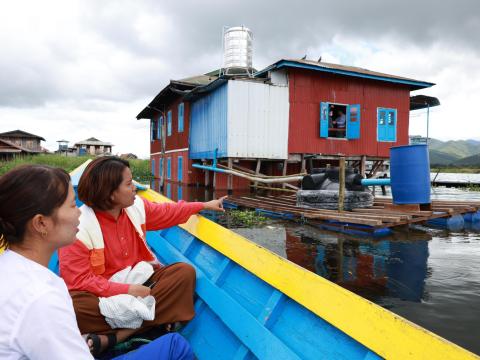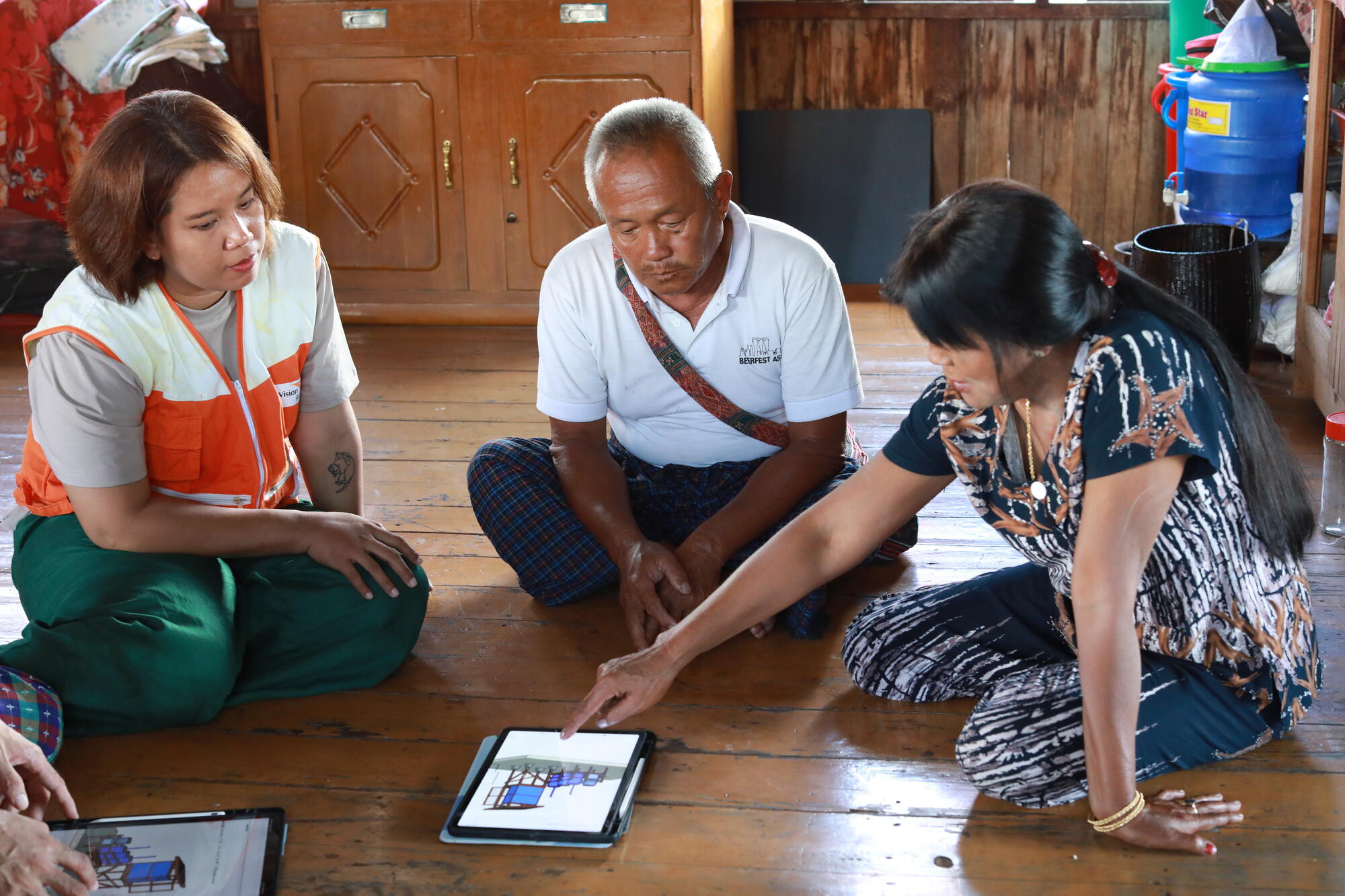
Turning the Tide: How Floating Toilets Are Building Climate Resilience in Myanmar’s Flood Zones
Dr. Edward Zan, Senior Operations and Response Director at World Vision Myanmar, warns that a climate crisis is rapidly unfolding in the flood-prone Inle Lake region—bringing with it a looming public health emergency. Amid rising waters and sanitation breakdowns, he spotlights a powerful community-led innovation that is redefining resilience. This approach offers a practical blueprint for safe, sustainable sanitation in fragile contexts, proving that local ingenuity can drive solutions even in the face of climate-driven disasters.
A Climate Crisis in Inle Lake
I have witnessed how climate change has reshaped life in Myanmar. It continues to make the country vulnerable to increasing risks of extreme weather events—cyclones, floods, heatwaves, and even droughts at times—that have become part of our reality. Rising temperatures and erratic rainfall threaten not just ecosystems, but lives and livelihoods.
Myanmar’s geography and socio-economic challenges make it one of the world’s most climate-vulnerable countries. Agriculture, water resources, and public health are under immense strain as these events intensify. The Inle Lake region, not spared from the intense climate change impacts, tells a stark story of ecological degradation. Once a lifeline for local communities, it now faces water shortages, ecological decline and disrupted livelihoods. Years of deforestation and unchecked expansion of floating gardens have weakened its resilience, leaving it prone to catastrophic flooding. Sedimentation has made the lake shallower, slashing its water storage capacity.
The combined impacts of the flood and the subsequent 2025 earthquake, causing untreated waste to flow into the lake, created severe public health risks—especially for children.

When Infrastructure Fails
In October 2024, when Cyclone Yagi struck, it submerged entire communities, destroying critical infrastructure. In the Intha ethnic villages, built on stilts above Inle Lake, traditional pit-less toilets collapsed, spilling raw sewage into the lake from where families get their drinking, cooking, and bathing water. The crisis worsened the following year, after a 7.7 magnitude earthquake in 2025 crippled health facilities. This compounded the aftermath of Cyclone Yagi: flooding and infrastructure collapse further contaminated water sources, destroying both sanitation systems and floating homes. Yet amid this escalating devastation, a new idea began to float—literally.
Turning Crisis into Opportunity
Emergencies can catalyse innovation. By planning for both immediate relief and long-term resilience, we can help communities stay safe and healthy even after the crisis ends. Inle Lake’s beauty masks its fragility. Pollution, sedimentation, and climate shocks have made waterborne diseases like Hepatitis A and diarrhoeal infections rampant. Children suffer most, with unsafe water contributing to illness and malnutrition. In response, World Vision Myanmar, in collaboration with local health authorities and community leaders, piloted an innovative solution: the floating toilet. Designed to be flood-resilient, environmentally safe and culturally appropriate, these toilets rise and fall with the water level, preventing waste from contaminating the lake.
What makes this toilet unique is the floating bio-septic tank, designed to rise and fall with fluctuating water levels, ensuring uninterrupted access to sanitation. At its core is a sealed biosptic tank that utilises anaerobic digestion and a three-chamber filtration process to treat waste before safely releasing it into Inle Lake—dramatically reducing pollution and associated health risks.

Community-Led Design and Ownership
Constructed with locally available materials and designed with community input, floating toilets ensure ownership, ease of maintenance, and long-term sustainability. Pilots in a rural health centre and nearby village have already shown promise in reducing contamination and restoring dignity. As Daw Myint, a resident of Inle, said: ‘This toilet is a promise that our children won’t fall sick every time it floods.’
Beyond viewing them as infrastructure, such projects unlock new possibilities—showing how innovation thrives when it is shaped by local context and community needs. Successful WASH (Water, Sanitation, and Hygiene) solutions must reflect local traditions and geography. Involving community leaders early, ensures designs align with cultural norms and use familiar materials. Education in local languages and training for caretakers further strengthen health outcomes and cultural pride.

Why Floating Toilets Work?
Floating toilets are especially effective in flood-prone areas. Their adaptability, ease of use, and alignment with local customs make them a practical and safe solution for water-based communities. When communities help design WASH systems, they work better and last longer. Local knowledge ensures the systems meet real needs, and using local tools and skills makes repairs easier. Involving everyone builds trust, encourages hygiene and can even reduce conflict. More than a stopgap, the floating toilet is a scalable model for flood-prone regions across Myanmar and beyond. But scaling requires more than good design. It demands flexible funding, policy support and a commitment to long-term resilience.
World Vision’s broader WASH programmes have already reached over 50,000 children in 2025 through sustainable water access, hygiene education and community-led sanitation. Yet the need is far greater. In places like Inle, where ecosystems are under threat and traditional livelihoods are disappearing, such WASH interventions are a lifeline – safeguarding health and resilience.

Inclusive and Climate-Resilient WASH
To be effective, WASH programmes must be inclusive and tailored to support children and ethnic minorities in fragile environments. This includes child-friendly facilities, culturally sensitive designs, and services linked to health and education. Climate-resilient technologies like floating toilets, water conservation practices, and local financing are key to long-term success. By listening to community needs and respecting local conditions, WASH interventions become more effective, equitable and sustainable.
Tracking Impact with mWater
To integrate floating toilets into national disaster and climate strategies, governments must update sanitation policies. Flexible standards, dedicated funding, and community involvement are essential to scale these solutions and protect public health. With tools like mWater, we’re tracking impact in real time, learning what works, and adapting quickly. This digital platform enables granular monitoring of toilet conditions, usage and community impact. Field teams register each latrine as a geospatial site, capturing data like installation date, toilet type, and recipient numbers. Photos and metadata allow for ongoing condition checks, while staff can flag issues—such as damage or overflow—directly on the map.
This live, map-based visibility transforms reactive maintenance into proactive planning. Overlaying latrine locations with population density and flood-risk data reveals coverage gaps—such as overcrowded units or communities still practicing open defecation. Decision-makers can query real-time data to calculate sanitation coverage, prioritise deployments and justify budgets with spatial evidence. By converting field observations into actionable insights, mWater empowers implementers to expand resilient sanitation where it’s needed most.
Scaling up requires collective action
To scale up such an initiative, floating sanitation must be integrated into climate adaptation plans, fund community-led WASH innovations, and use tools like mWater to scale impact. As climate-induced disasters intensify, we need to reflect on how we approach sanitation in flood-prone regions. Pilot initiatives like floating toilets demonstrate the transformative potential of locally adapted WASH solutions. These adaptive solutions offer a blueprint for sustainable service delivery in fragile environments. This World Toilet Day, let us challenge conventional thinking and invest in resilient, inclusive sanitation systems, especially for communities hit hardest by climate-related disasters. Floating toilets are a symbol of what’s possible when communities, innovators, local authorities and development actors co-create solutions that respond to lived experiences.
We can turn crisis into opportunity by supporting community-driven innovations that protect health, preserve ecosystems and uphold dignity. Investing in innovative, floating solutions means communities can stay resilient—and children’s futures can rise above the floodwaters.
About the Author:
Dr. Edward Zan is the Senior Operations and Response Director, World Vision International Myanmar. He leads country operations and oversees the implementation of development and humanitarian programmes. Dr. Zan is also a public health physician with extensive experience in the public/ government sector, private sector, and academia as well as in relief and development. He obtained his medical degree from the University of Medicine in Yangon and received his Master of Public Health (MPH) from the Emory University, Atlanta Georgia, USA. He also has a Master of Arts degree in Community Development from the Myanmar Institute of Theology.
